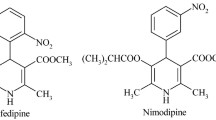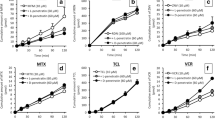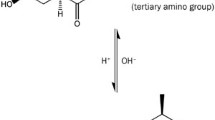Abstract
Purpose. To compare the intestinal absorption and active efflux protein susceptibility of a new immunosuppressive agent (SDZ-RAD) with that of its analog rapamycin.
Methods. Caco-2 cell monolayers were used to examine bidirectional transport of the two compounds at low micromolar concentrations. Single pass rat intestinal perfusion was also used to examine steady state permeability.
Results. Rapamycin and SDZ-RAD showed a distinct preference for transport in the basolateral to apical direction of Caco-2 monolayers as efflux was >20 times greater than apical to basolateral transport. Efflux of SDZ-RAD was completely inhibited by verapamil while efflux of rapamycin was mostly inhibited by verapamil and partially inhibited by probenecid. Passive permeability was shown to be 20 × 10−6 cm/sec for SDZ-RAD and 10 × 10−6 cm/sec for rapamycin. In situ rat studies also showed the permeability of rapamycin to be half that of SDZ-RAD with permeabilities of 12.6 × 10−6 for rapamycin and 24.8 × 10−6 cm/sec for SDZ-RAD.
Conclusions. SDZ-RAD and rapamycin are strong substrates for P-gp-like mediated efflux. Rapamycin is also partially removed from cells by a second efflux system that is not responsive to SDZ-RAD. When these efflux pumps are inhibited SDZ-RAD is likely to be absorbed across the intestine at a faster rate than rapamycin.
Similar content being viewed by others
REFERENCES
V. P. Shah, A. Yacobi, W. H. Barr, L. Z. Benet, D. Breimer, M. R. Dobrinska, L. Endrenyi, W. Fairweater, W. Gillespie, M. A. Gonzalez, J. Hooper, A. Jackson, L. J. Lesko, K. K. Midha, P. K. Noonan, R. Patnaik, and R. L. Williams. Evaluation of orally administered highly variable drugs and drug formulations. Pharm. Res. 13:1590–1594 (1996).
R. Morris. Modes of action of FK506, cyclosporin A, and rapamycin. Transplant. Proc. 26:3272–3275 (1994).
G. M. Ferron, E. V. Mishina, J. J. Zimmerman, and W. J. Jusko. Population pharmacokinetics of sirolimus in kidney transplant patients. Clin. Pharmacol. Ther. 61:416–428 (1997).
C. Cordon-Cardo, J. P. O'Brien, D. Casals, L. Rittman-Grauer, J. L. Biedler, M. R. Melamed, and J. R. Bertino. Multidrug-resistance gene (P-glycoprotein) is expressed by endothelial cells at blood-brain barrier sites. Proc. Natl. Acad. Sci. USA 86:695–698 (1989).
F. Thiebaut, T. Tsuruo, H. Hamada, M. M. Gottesman, I. Pastan, and M. C. Willingham. Cellular localization of the multidrug-resistance gene product P-glycoprotein in normal human tissues. Proc. Natl. Acad. Sci. USA 84:7735–7738 (1987).
P. F. Augustijns, T. P. Bradshaw, L. L. Gan, R. W. Hendren, and D. R. Thakker. Evidence for a polarized efflux system in Caco-2 cells capable of modulating cyclosporin A transport. Biochem. Biophys. Res. Com. 197:360–365 (1993).
T. Hoof, A. Demmer, U. Christians, and B. Tümmler. Reversal of multidrug resistance in chinese hamster ovary cells by the immunosuppressive agent rapamycin. Eur. J. Pharm. Mol. Biol. 246:53–58 (1993).
S. P. Cole, G. Bhardwaj, J. H. Gerlach, J. E. MacKie, C. E. Grant, K. C. Almquist, A. J. Stewart, E. U. Kurz, A. M. Duncan, and R. G. Deeley. Overexpression of a transporter gene in a multidrug-resistant human lung cancer cell line. Science 258:1650–1654 (1992).
T. Nguyen and S. Gupta. Leukotriene C4 secretion from normal murine mast cells by a probenecid-Sensitive and multidrug resistance-associated protein-independent mechanism. J. Immunol. 158:4916–4920 (1997).
P. Artursson, K. Palm, and K. Luthman. Caco-2 monolayers in experimental and theoretical predictions of drug transport. Adv. Drug. Del. Rev. 22:67–84 (1996).
E. Hofsli, and J. Nissen-Myer. Reversal of multidrug resistance by lipophilic drugs. Cancer Res. 50:3997–4002 (1990).
S. Gollapudi, C. H. Kim, B. Tram, S. Sangha, and S. Gupta. Probenecid reverses multidrug resistance in multidrug resistance-associated protein-overexpressing HL60/AR and H69/AR cells but not in P-glycoprotein-overexpressing HL60/Tax and P388/ARD cells. Cancer Chemother. Pharmacol. 40:150–158 (1997).
P. Artursson. Epithelial Transport of Drugs in Cell Culture. I: A model for studying the passive diffusion of drugs over intestinal absorbtive (Caco-2) cells. J. Pharm. Sci. 79:476–482 (1990).
P. Artursson and J. Karlsson. Correlation between oral drug absorption in humans and apparent drug permeability coefficients in human intestinal epithelial (Caco-2) cells. Biochem. Biophys. Res. Comm. 175:880–885 (1991).
B. H. Stewart, O. H. Chan, R. H. Lu, E. L. Reyner, H. L. Schmid, H. W. Hamilton, B. A. Steinbaugh, and M. D. Taylor. Comparison of intestinal permeabilities determined in multiple in vitro and in situ models: Relationship to absorption in humans. Pharm. Res. 12:693–699 (1995)
V. C. Dias, and R. W. Yatscoff. Investigation of rapamycin transport and uptake across absorptive human intestinal cell monolayers. Clin. Biochem. 27:31–36 (1994).
F. Delie and W. Rubas. A Human colonic cell line sharing similarities with enterocytes as a model to examine oral absorption: Advantages and limitations of the Caco-2 model. Crit. Rev. Ther. Drug Carr. Sys. 14:221–286 (1997).
M. M. Nerurkar, N. F. H. Ho, P. S. Burton, T. J. Vidmar, and R. T. Borchardt. Mechanistic roles of neutral surfactants on concurrent polarized and passive membrane transport of a model peptide in Caco-2 cells. J. Pharm. Sci. 86:813–821 (1997).
P. Wils, V. Phung-Ba, A. Warnery, D. Lechardeur, S. Raeissi, I. Hidalgo, and D. Scherman. Polarized transport of docetaxel and vinblastine mediated by P-glycoprotein in human intestinal epithelial cell monolayers. Biochem. Pharm. 48:1528–1530 (1994).
I. Brock, D. R. Hipfner, B. S. Nielsen, P. B. Jensen, R. G. Deeley, S. P. Cole, and M. Schested. Sequential coexpression of the multidrug resistance genes MRP and mdr1 and their products in VP-16 etoposide)-selected H60 small cell lung cancer cells. Cancer Res. 55:459–462 (1995).
E. Dolfini, T. Dasdia, G. Arancia, A. Molinari, A. Calcabrini, R. J. Scheper, M. J. Flens, M. B. Gariboldi, and E. Monti. Characterization of a clonal human colon adenocarcinoma line intrinsically resistant to doxorubicin. Br. J. Cancer 76:67–76 (1997).
R. Evers, G. J. Zaman, L. van Deemter, H. Jansen, J. Calafat, L. C. Oomen, R. P. Elferink, P. Borst, and A. H. Schinkel. Basolateral localization and export activity of the human multidrug resistance-associated protein in polarized pig kidney cells. J. Clin. Invest. 97:1211–1218 (1996).
M. Kavallaris. The role of multidrug resistance-associated protein (MRP) expression in multidrug resistance. Anti-Cancer Drugs 8:17–25 (1997).
L. L. Gan, M. A. Moseley, B. Khosla, P. F. Augustijns, T. P. Bradshaw, R. W. Hendren, and D. R. Thakker. CYP3A-like cytochrome P450-mediated metabolism and polarized efflux of cyclosporin A in Caco-2 cells: Interaction between the two biochemical barriers to intestinal transport. Drug Met. Dis. 24:344–349 (1996).
L. L. Gan and D. R. Thakker. Application of the Caco-2 model in the design and development of orally active drugs: Elucidation of biochemical and physical barriers posed by the intestinal epithelium. Adv. Drug. Del. Rev. 23:77–98 (1997).
V. J. Wacher, L. Salphati, and L. Z. Benet. Active secretion and enterocytic drug metabolism barriers to drug absorption. Adv. Drug Del. Rev. 20:99–112 (1996).
C. L. Crespi, B. W. Penman, and M. Hu. Development of Caco-2 cells expressing high levels of cDNA-derived cytochrome P4503A4. Pharm. Res. 13:1635–1641 (1996).
U. Fagerholm, M. Johansson, and H. Lennernäs. Comparison between permeability coefficients in rat and human jejunum. Pharm. Res. 13:1336–1342 (1996).
Author information
Authors and Affiliations
Rights and permissions
About this article
Cite this article
Crowe, A., Lemaire, M. In Vitro and In Situ Absorption of SDZ-RAD Using a Human Intestinal Cell Line (Caco-2) and a Single Pass Perfusion Model in Rats: Comparison with Rapamycin. Pharm Res 15, 1666–1672 (1998). https://doi.org/10.1023/A:1011940108365
Issue Date:
DOI: https://doi.org/10.1023/A:1011940108365




